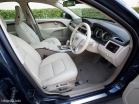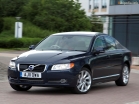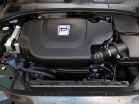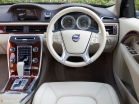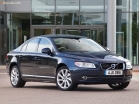Wilvo S80 test drive since 2011 sedan
New Swedish
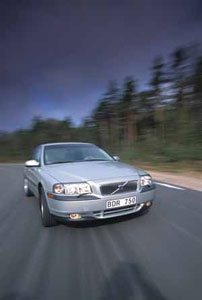 A new car is always interesting. But the Volvo S80 sedan causes interest not so much in itself as the fact that it is built on the new large P23 platform, which forms the basis of other models of the company.
A new car is always interesting. But the Volvo S80 sedan causes interest not so much in itself as the fact that it is built on the new large P23 platform, which forms the basis of other models of the company. In the traditional sense, the platform is what makes up the lower part of the car, i.e. Paul, chassis and power unit. Unification of platforms allows you to accelerate and reduce the cost of the release of new models. Volvo understands this and has already done about half the work necessary to create a series of future cars on a new common platform. The S80 model replaced the 90th series, the only Volvo in the modern range, which still has a rear-wheel drive. Now the whole gamut of ordinary cars of the company is front -wheel drive (except for all -wheel drive modifications).
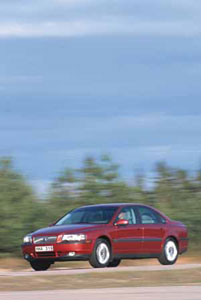 In the rules of the company - never apply about your plans. Volvo prefers to put an audience (and competitors) before the accomplishment. So now it’s hard to say anything specific about the future line of models. Closer to the fall, apparently, you can expect some information about Volvo S60. In 1999-2000, the V90 station wagon will probably be replaced. Probably, a full -wheel drive version will appear ...
In the rules of the company - never apply about your plans. Volvo prefers to put an audience (and competitors) before the accomplishment. So now it’s hard to say anything specific about the future line of models. Closer to the fall, apparently, you can expect some information about Volvo S60. In 1999-2000, the V90 station wagon will probably be replaced. Probably, a full -wheel drive version will appear ... But back to the car, which was shown by the automobile - mainly American - the press on May 28 in Gothenborg.
So, Volvo S80. Sedan. Front -wheel drive. Big. Rounded shapes. Beautiful. To date, the most luxury of the company's cars. Must import Volvo into the sector of expensive and prestigious cars, primarily in the American market. The cost of a car in the United States has already been determined - from $ 35,000. Competitors: Saab 9-5 V6, BMW 5th series, Mercedes E-class, Audi A6, Lexus GS300.
 Engines
Engines A large car should have a large motor. With such - the American - approach, the creators of the S80 agree, which once again indicates exactly where they are going to sell a new model. Nevertheless, the largest engine provided for the car has a volume of only 2.9 liters. The lack of cubic centimeters of the Swedes is compensated by turbocharged and cunning technologies.
The line of engines proposed for the S80 belongs to the RN (Revised N) family, which means modernized N. The modernization of the previous generation engines is thoroughly carried out - in some of them up to 90% of the components were replaced. All motors are still in line: in this case, the company is not going to change its addictions. Engines - for every taste, five options for 5 -cylinder (two are already ready, three will appear later) and two - 6 -cylinder.
Both 5-cylinder engines are 2-liter (1984 cm cubic) with a boost. The low -pressure boot engine (B5204T4) is installed on the S80T version, it develops a power of 163 hp. (5100 vol./Min.) And torque 230 Nm (1800-5000 rpm). The high -pressure boost engine (B5204T3) is equipped with a S80T5 version. Its power is 226 hp. (5100 vol./Min.), The maximum torque is 310 nm (2700-5000 rpm). Fuel consumption does not exceed 10 l/100 km.
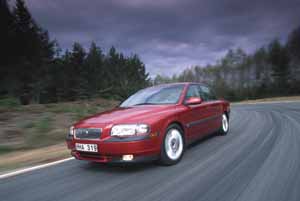 Three more 5 -cylinder engines will appear during the year - atmospheric B5244S (2435 cm cubic meter, 170 hp, 230 nm), atmospheric B5244S2 of the same volume, but lower power (140 hp, 230 nm) and 2) and 2) and 2 , 5 l of the D5252T turbodiesel, which was used in S70 and V70 models. Of the two 6 -cylinder engines, one atmospheric, the other with a boost. Atmospheric B6304S (2922 cm cubic meter, 204 hp, 280 nm) - this is a processed 3 liter of six. The boost of 2.8 l of the B6284T motor is the most powerful in the gamut (272 hp, 380 nm), it is installed on the S80T6 version. The engine is equipped with two turbochargers, each of which works for three cylinders. The advantages of such a scheme are a faster reaction by reducing the mass of the turbine.
Three more 5 -cylinder engines will appear during the year - atmospheric B5244S (2435 cm cubic meter, 170 hp, 230 nm), atmospheric B5244S2 of the same volume, but lower power (140 hp, 230 nm) and 2) and 2) and 2 , 5 l of the D5252T turbodiesel, which was used in S70 and V70 models. Of the two 6 -cylinder engines, one atmospheric, the other with a boost. Atmospheric B6304S (2922 cm cubic meter, 204 hp, 280 nm) - this is a processed 3 liter of six. The boost of 2.8 l of the B6284T motor is the most powerful in the gamut (272 hp, 380 nm), it is installed on the S80T6 version. The engine is equipped with two turbochargers, each of which works for three cylinders. The advantages of such a scheme are a faster reaction by reducing the mass of the turbine. All motors are multi -valve, with an electronic drive of the throttle and variable phases of gas distribution. In atmospheric engines, the CVVT system is installed on the camshaft, which controls the intake valves, and solves the main task - to increase the torque at low speeds. In the Motor version of the S80T6 - on the contrary: the system is on the shaft that controls the exhaust valves, due to which a decrease in the toxicity of the exhaust is achieved. By the way, this motor is equipped with two catalytic neutralizers, in each of which two oxygen sensors ...
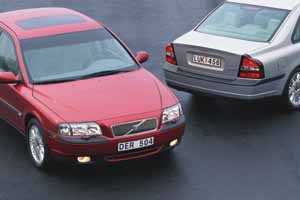 TRANSMISSION
TRANSMISSION VOLVO engineers had to work hard in order to place a in -line six across the motor compartment. The main problems with the chosen diagram of the location of the box are associated with its size. Even when creating a mechanical box of M56 for Volvo 850 (it is also used on S80 with 5 -cylinder engines), they found an interesting technical solution - it made it a trivne, which made it possible to significantly reduce the length. In the design of the M65 box designed for 6-cylinder engines, the same approach was used. The box turned out to be 4 -vane, and, therefore, even shorter - only 297 mm in length, while it is capable of transmitting a torque of 380 nm.
 Partners of the mechanical M56 and M65 are automatic GM4T65E and AW5042. As follows from the markings, they are created using, respectively, the General Motors corporation and Aisin Warner. Both are four -speed, 6 -cylinder engines are the first, the second - 5 -cylinder with turbocharged. All boxes are adaptive, adapting to the individual manners of the driver.
Partners of the mechanical M56 and M65 are automatic GM4T65E and AW5042. As follows from the markings, they are created using, respectively, the General Motors corporation and Aisin Warner. Both are four -speed, 6 -cylinder engines are the first, the second - 5 -cylinder with turbocharged. All boxes are adaptive, adapting to the individual manners of the driver. For the S80T6 version there is a modification (GM4T65EG) - with the Geartronic system as an option. GEARTRONIC, similarly to the well -known systems of other manufacturers (Tiptronic, Steptronic), allows you to control the automatic box as a sectral mechanical one. In addition, in the drive of the wheels of the S80T6 there is a viscous coupling.
 ELECTRONICS
ELECTRONICS In the first Volvo 1927 there were 30 meters of wiring and 4 fuses. In the models of 1997, the length of the wires reached 1200 meters, and the number of fuses increased to 54. And - connectors, connectors ... It became clear that the path of extensive development is at a dead end ...
In the S80 model, another path is implemented. A computer network was created in the car - as in any normal office. All 18 computers and 24 electronic modules of the car communicate with each other according to the only common cable in the language of zeros and units. As a result, not only the overall reliability of the scheme increased, but also the possibility of its simpler development: adaptation to various modifications of the car, the installation of additional equipment ... In addition, the operation of self -diagnosis systems improved, and maintenance was simplified.
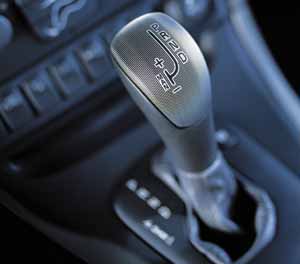 There are enough electronics in the car - even if you do not take into account a very difficult engine control scheme. For example: Electronic chassis control systems - STC and DSTC. Both use ABS sensors and standard brake mechanisms.
There are enough electronics in the car - even if you do not take into account a very difficult engine control scheme. For example: Electronic chassis control systems - STC and DSTC. Both use ABS sensors and standard brake mechanisms. The first (Stability and Traction Control) is essentially a combination of the TracS system, which is used on models of the 70th series, and the DSA system, which is used on S40 and V40 machines. Both are previously tested and described by the engine. In short, the STC eliminates the slipping of the wheels, brakes sliding and, if necessary, reducing the torque transmitted to it by reducing the supply of fuel. The system is included in the standard set of S80T6 and is an option for other modifications.
The second (Dynamic Stability and Traction Control) solves the problem of maintaining the exchange rate stability of the car. The system measures the speed of rotation of the wheels, the angle of rotation of the lamb and the direction of movement. When the rear axle is dried, the corresponding front wheel is braked - so that the car returned to a given course. DSTC will first be installed only on models with 6-cylinder engines.
 Brakes
Brakes Both front and rear brakes are disk (front - ventilated), with floating brackets. Of course, there are ABS and an electronic controller of the EBD brake force, which increases the braking efficiency, integrated with it, which increases the braking efficiency (especially if the car is strongly loaded).
SUSPENSION
The front suspension in design is very similar to the suspension of the 70th series - only the geometry is slightly changed. There is a reptile stability stabilizer, measures have been taken to reduce clinks during braking or acceleration.
The rear multi -leaf pendant with the effect of steering is collected on a powerful aluminum subframe, which is attached to the body through rubber pillows that reduce noise and vibration. The subframe also performs protective functions: covers the gas tank when hitting the back. As an option, an automatic body aligning system is provided - NIVOMAT.
STEERING
The steering has a gear/rail circuit and, of course, is equipped with an amplifier with a variable characteristic. The performance of the pump changes depending on speed. From a click to a click - only three rulings of the steering wheel. The column is adjustable - both in length and in the corner of inclination.
 BODY
BODY The S80 body has a very high stiffness on longitudinal twisting, which reaches 18.6 kNM/degrees (usually this indicator for sedans is in the range of 6-14). If you transform these numbers into a visual image, it will turn out the following. One and a half -ton load (Volvo S80 weight) on the front wheel will lead to twisting the body within one degree - even the eye is imperceptibly. And, as you know, the tougher the body, the better handling ...
By the way, the car is close to perfect, 57% of the weight falls on the front axle, 43% - on the rear. It’s not easy to achieve this in the front-wheel drive car: I even had to transfer the battery to the trunk.
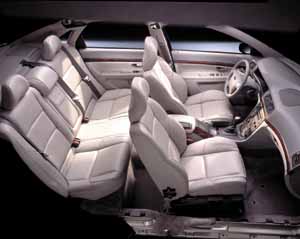 SALON
SALON Describe in detail the car interior is an ungrateful occupation. We limit ourselves to the assertion that its decoration and equipment are fully consistent with the class of the car.
In addition to the usual, the driver's seat also has an adjustment of the pillow in height and angle of inclination. Two -stage heating, and with different preferences of intensity: depending on the material of the upholstery. Electric adjustments and heating of external mirrors, which can also be folded when parking in tight places. Four options for a built -in audio system - depending on the level of equipment of the machine. The top version has four amplifiers with a capacity of 50 watts, a radio receiver, a CD changer, a mini-disk player, the Dolby Surround Pro Logic processor and 9 speakers. The control buttons are put on the steering wheel. The RTI information system integrated into the radio receiver is unlikely to be useful, but the GSM standard phone is interesting: in this standard we have some mobile communications companies. The phone, however, is the option.
 SAFETY
SAFETY One of the rules of the company - each subsequent model should be safer than the previous one. Volvo representatives have always chosen expressions very carefully, speaking of the safety of their cars - they carefully avoid direct comparisons: it is fraught ... But this time the Swedes surpassed themselves (we quote): probably it will not be an exaggeration that Volvo S80 is the safest is the safest Passenger car in today's market.
He is large - there is where to place the crushed areas. Three -point belts in all five places, and even with a pyrotechnic pretension. Belts work in agreement with airbags. The front passenger pillow has two operation modes - depending on whether the belt is fastened (American influence is felt again). The Whips system on the front seats, reducing the likelihood of damage to the cervical vertebrae when hitting the back ... the well -known SIPS system (door and side pillows), supplemented by an inflatable curtain that protects their heads with a lateral blow ... It is unlikely that any of the competitors will take the risk of applying for company in the company Court for unscrupulous advertising ...
A few words in conclusion. The Norwegian company Haufoss, producing bumpers, recently sharply, up to 500,000 per year, increased production capacity - after receiving the order from Volvo for the manufacture of rear bumper for the S80. Of course, not all products will go to Sweden, but Volvo optimism regarding the prospects of its new model is clearly felt. And yet - given the Volvo plans for the development of the Russian market, it is possible that the S80 will be brought to the Moscow car dealership this year ...
Mikhail Vasiliev
Source: Motor magazine [No. 7/1998]

